June 19, 2015
Air Date: June 19, 2015
FULL SHOW
SEGMENTS
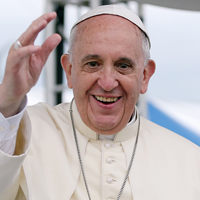
Pope Calls for Harmony With Nature To Save Humanity
View the page for this story
Pope Francis's highly-anticipated Encyclical, “Laudato Si,” subtitled “On Care for Our Common Home,”included a call for action on global warming, but the 184-page document offers much more than policy recommendations. It's a poetic, emotional call for a fundamental shift in our economic system, and a rethinking of our relationship with God's creation: the natural world. Assistant Professor of Theology, Science and Ethics at Fordham University, Christiana Peppard, discusses with host Steve Curwood the Pope's message to people to be moral stewards of the planet and rectify ecological and social injustices plaguing the world today. (12:45)
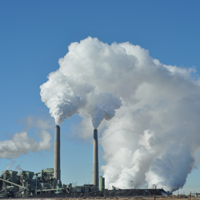
Cleaning Up the Power Sector
View the page for this story
EPA administrator Gina McCarthy joins host Steve Curwood to talk about her agency’s efforts to reign in CO2 emissions from the countries power plants, big trucks, gas fields, and airplanes. She says the EPA’s global warming efforts put the United States in a good position to be a leader at the Paris climate negotiations in the fall. (11:00)
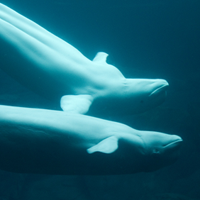
Beyond the Headlines
/ Peter DykstraView the page for this story
In this week’s Beyond the Headlines, Peter Dykstra tells host Steve Curwood about beluga whales spotted in Jersey waters, a Weather Channel redemption story, and classic summer blockbuster hits with environmental themes. (04:25)
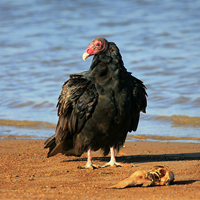
BirdNote®: A Big Black Gas Leak Detector
/ Mary McCannView the page for this story
Identifying natural gas leaks from pipelines is important, but with over 300,000 miles of pipe in US, the task can be a daunting one. But as BirdNote®’s Mary McCann reports, a serendipitous tip from an oil worker helped an ornithologist solve mysteries about turkey vultures’ scavenging behavior and interest in gas lines. (02:00)
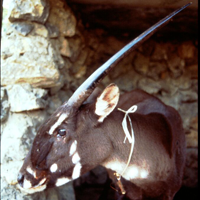
The Quest for the ‘Asian Unicorn’
View the page for this story
Deep in the forests of Southeast Asia lives a creature that, in profile, looks like a unicorn, but it’s almost as rare as that mythic beast. The saola is related to wild cattle, but little is known about it, except that it and its habitat are disappearing. In this conversation, author William deBuys discusses his book The Last Unicorn with host Steve Curwood and explains his quest to the jungles of Laos in search of the rare saola. (16:20)
Show Credits and Funders
Show Transcript
HOST: Steve Curwood
GUESTS: Christiana Peppard, Gina McCarthy, William deBuys
REPORTERS: Peter Dykstra, Mary McCann
[THEME]
CURWOOD: From Public Radio International, this is Living on Earth.
[THEME]
CURWOOD: I'm Steve Curwood. Pope Francis takes a stand on global warming and environmental damage, with a call to the faithful that resonates for all of humanity.
PEPPARD: This is a very acutely important moment in terms of thinking about the global common good — not just about nationalities, but about what it means to be human on a changing planet, and what role we bear in that.
CURWOOD: EPA chief Gina McCarthy says the Pope’s encyclical helps the US make a strong case for action at the Paris climate talks.
MCCARTHY: So what the President wanted to do is actually happening. He wanted to show that if the US takes strong domestic action, we can engage other big players like China, which we have engaged. And in Paris we can have an entirely different discussion.
CURWOOD: That and more this week on Living on Earth. Stick around.
[NEWSBREAK MUSIC: Boards Of Canada “Zoetrope” from “In A Beautiful Place Out In The Country” (Warp Records 2000)]
ANNOUNCER: Support for Living on Earth comes from United Technologies – innovating to make the world a better, more sustainable, place to live.
Pope Calls for Harmony With Nature To Save Humanity

Pope Francis was a chemical technician in Argentina before joining the seminary. (Photo: Korean Culture and Information Service, CC BY-SA 2.0)
CURWOOD: From the Jennifer and Ted Stanley Studios in Boston and PRI, this is Living on Earth. I'm Steve Curwood. There has been probably no more eagerly-awaited pronouncement on the question of climate and environmental degradation, and the risks to the poor ,than the encyclical just delivered by Pope Francis. The charismatic Pope is not only the leader of the planet’s billion Roman Catholics, he has also caught the admiration and imagination of billions more. And his background with a degree in chemistry makes him a formidable adversary to those who pooh-pooh the scientific consensus and attempt to deny that humans are changing the planet’s atmospheric chemistry with heat-trapping gases. To put the Pope’s encyclical in context, we are joined on the line now from New York by Christiana Peppard, Assistant Professor of Theology, Science and Ethics at Fordham University. Welcome back to Living on Earth, Christiana.
PEPPARD: Thanks, Steve. It's wonderful to be here on such a happy occasion.
CURWOOD: So let's start off first with some basics. What exactly is an encyclical and how important are they?
PEPPARD: An encyclical is an authoritative teaching document issued by a pope that addresses issues of faith and morality, generally having to do with issues that are coming up in contemporary life. To the question of how important encyclicals are, they're really, really important. They're among the most authoritative teachings that the Catholic church has. And they're meant to be guidelines: sets of moral guidelines, frameworks, paradigms, reference documents to guide Catholics and Bishops and people of goodwill in thinking about matters of common concern.
CURWOOD: The headlines on this encyclical have focused on the warming climate and the Pope's call for the phaseout of fossil fuels, but before we get to some specifics, let's talk about the Pope's overall approach here. This encyclical opens by calling for a new and universal solidarity among humans. What's he talking about?
PEPPARD: Right. That's a vast idea that sounds like it might have something to do with the climate, and it does. But you're absolutely right that it's not just a climate encyclical. This is, as I see it, a real salvo from the Pope to all of humanity asking for universal solidarity on issues of common concern and especially on the question of the Earth, — or, in theological language, creation. He leads with the fact that the planet is falling into a state of disrepair, people are deeply mired in poverty, and this represents a failure of human responsibility. So his invitation is to a renewed, transformative form of responsibility and global solidarity with one another, involving care for the Earth as our common home. So that’s part of why the document is subtitled, "On the care of our common home."
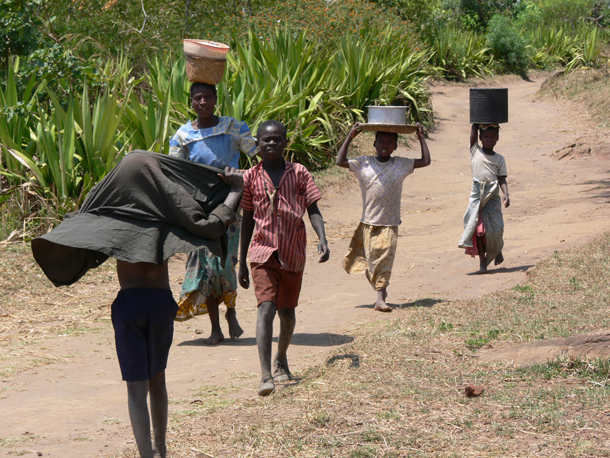
Children hauling water in Malawi. Pope Francis points to global inaccessibility and inequity of environmental resources as a problem, and the burden of this consumption issue often falls on those least responsible for it. (Lars Plougmann, CC BY-SA 2.0)
CURWOOD: Now, what kind of relationship is the Pope calling for humans to have with nature, what he calls creation?
PEPPARD: Yeah, you know, this document is really fascinating because it draws on established Catholic social teaching on the environment, some ideas that really got going with Pope John Paul II and Pope Benedict XVI. But at the heart of this document is relationships. So I would say that far more than being a policy white paper or a political précis on how various international negotiations ought to proceed, it's a document on ethics, it's a document of moral vision. And it's calling for a transformation in the way we regard our relationships: between humans and God, humans and each other, and humans and the planet. And the Pope's diagnosis is that there are real spiritual malaises, as well as structural impediments, to the right functioning of those relationships at present. The Pope says the church has interpreted humans as having dominion over the planet, and that dominion has too often been lived out as domination. Christians and Church history who have done this are wrong. We need to get back to a better and more accurate interpretation, and here's what that would look like.
CURWOOD: So, in this, he seems very concerned about environmental refugees. What do you think motivated that?
PEPPARD: I think the Pope sees a lot of the dynamics of environmental degradation globally as driven by economic structures of profit, and a focus on economic development and growth that is not accountable to the limitations of what the planet can absorb. And it is not accountable to the burdens that are carried by people living in poverty. So, as a Pope who comes from South America, who spent time in slums, who has written extensively about the lives of the poor and problems of neocolonialism, and who has had critiques, frankly, of what he has called the deified market, making the market into something like an idol or God — he’s very concerned with the fact that people no longer have homes, literally and metaphorically. So environmental refugees, you know that's a huge problem for people displaced by, say, large dams or rapid desertification. But it's also a spiritual problem in, as he writes, "everyone needs a home and is entitled to a home."
CURWOOD: Let's talk about his economics. How radical is his vision? It sounds like he's calling for a revolution in this document.
PEPPARD: You know, I think he is. I think he is calling for a revolution. Now it's never going to be a violent revolution, it's never going to be reducible to endorsing a particular form of political economy. But what he's saying is so much in line with what folks like Gus Speth and others thinking about the new economy have been talking about. And that is simply that there need to be moral limits on economic quote on quote progress. So he writes about in an era where human creativity has issued forth in robust kinds of technological advances and the creation of amazing wealth. The fact of the matter is that inequalities persist. And he has a great quote in the document where he says that the environment is deteriorating, and we still have not solved the problem of poverty. And he goes on to explain how our moral capabilities and our powers of reflection and action have not caught up with the powers of our technology and our economic systems. And that is to the detriment of all of us, especially the planet and the poor.
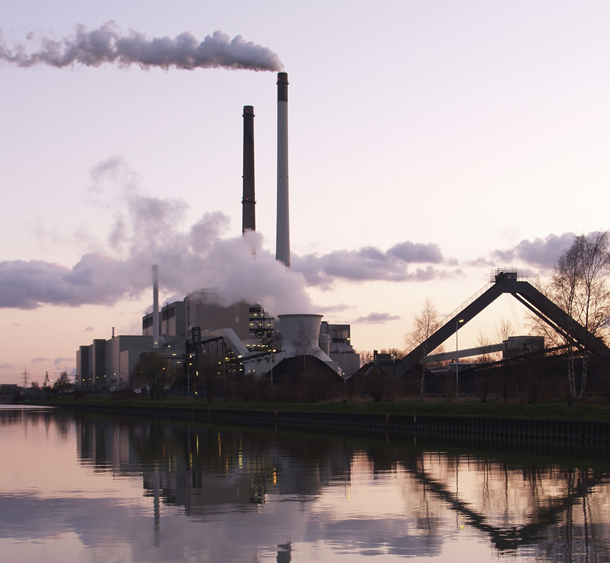
A coal power plant in Germany. The Pope says that consumption of non-renewable resources is destroying our common home. (Photo: Arnold Paul, CC BY-SA 3.0)
CURWOOD: Now, specifically on the climate, he says, look, humans are responsible for most of what's going on, and in terms of the international negotiations, he calls for us to deal with them with “common and differentiated responsibilities.” What does he want? What's he talking about?
PEPPARD: Well, the language of “common and differentiated responsibilities” is one that you see in diplomacy and in the history of negotiations over international climate treaties. So, I think that the Pope has a significant, powerful audience in mind for this encyclical. Yes, it's directed to everyone on the planet, but there are a lot of passages that are directed towards super developed nations, such as our own. And what he says here is that while there have been some successful international treaties in the past, there have also been some real failures — the Kyoto Protocol, for example, and even more recent climate negotiations. And he is extremely and really quite exquisitely clear that the burdens have been caused by certain industrial actors — we are central among them — and the responsibility for them must be taken on primarily by those countries which have benefited the most. So he uses the language here of an ecological and social debt that highly developed nations owe to less developed nations. And this is really powerful language. He even goes so far as to say, in terms of particular options, that he's unconvinced that carbon pricing or cap-and-trade would do anything more than simply be a bandage, that doesn't amount to the radical change that is required by the situation. And that's his phrase, the radical change that is necessary.
CURWOOD: Yeah, looking at that section where he has his strategy of buying and then selling carbon credits can lead to a new form of speculation, and it goes onto say it may simply become a ploy which permits maintaining the excessive consumption of some countries and sectors.
PEPPARD: Exactly.
CURWOOD: Now, consumption is the problem from his perspective in this — not population — and he talks about, let me quote him here, this paradigm over consumption that leads people to believe that they are free as long as they have the supposed freedom to consume. What does he mean?
PEPPARD: What the Pope is saying in this document is that the idea of human freedom as amounting to what we can buy, or what we can consume, that gives us momentary utility or pleasure — he thinks that is an impoverished form of freedom. He talks about the need for an authentic human freedom that means, for example, that all people have basically livable standards of life, including, he talks about in paragraph 30 — one of my particular interests — the right to clean water, and various other fundamental issues that undergird the right to a life with dignity. Obviously population politics, reproduction, and the Catholic Church — that’s a big topic, and the Pope doesn’t really get into the reproductive aspects, or sexual ethics or any of that. What he says — and frankly, I think he’s right, at least on this part — is that we cannot merely think about the environmental crisis as a problem of sheer numbers. That is just flat footed. Yes, people impact the planet, so, logically, it would make sense that more people would impact the planet more. But he rightly points out that there are certain sectors of humanity, I’m among them, you’re among them, the listeners on this show are among them, who consume so much more than our fair share, that we really need to take a look at our own mentalities of consumption and the spiritual malaise that accompanies them.
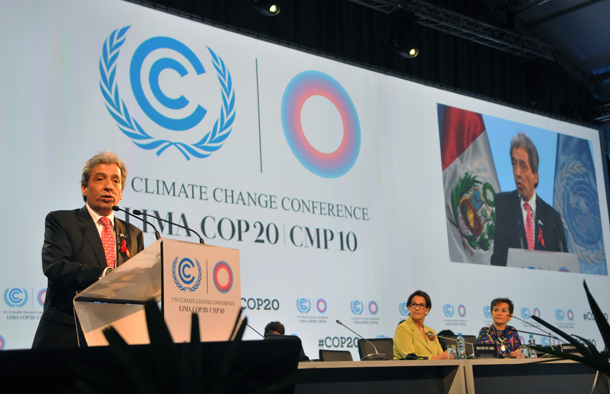
In chapter five of the encyclical, Pope Francis discusses the environment and our responsibility as an international community to it and each other. More and more, climate talks and negotiations like the 1992 Earth Summit and 2014’s COP20 set out to cooperate to reduce global pollution and fix social injustices but ultimately fall flat due to inaction and non-compliance. (Photo: Elekhh, Wikimedia CC BY-SA 2.0)
CURWOOD: So what happens next? If this is a letter to the world’s Catholic bishops, what do they do with it?
PEPPARD: That is a great question, and in a sense, that is the question that everyone wants to know. I think the timing of the encyclical is clear. There are big negotiations coming up about international treaties and collaborative goals and opportunities for what he calls universal solidarity. So I think next steps are to really think hard and with humility about how we, as a nation, individuals and our representatives, can move forward in participating in a more just and inclusive world. But then there are questions at the individual level, or for bishops or priests or parishes. I’m not as involved in those aspects of things, I’m more on the ethics and scholarship side. But, as a professor and as someone who has been struck by the powerful analyses in this document, my hope is actually that people sit down with it and read it. Even if it’s bit by bit, or little by little, all 246 paragraphs — not with the idea that it needs to be analyzed and that it provides a specific road map of who to vote for; it doesn’t. But to read it as a document of contemplation, and to try to see with the eyes of poetry and beauty and ethics what the pope might be asking of us, and what various ways of living that out might be. Not everyone’s going to agree with everything in there, but the document really is an invitation and a set of principles for moral reflection.
CURWOOD: Ever the pastor, Pope Francis. Christiana Peppard is an assistant professor of theology, science, and ethics at Fordham University. Christiana, thanks so much for taking the time with us today.
PEPPARD: Thank you for having me, Steve.
Related links:
- Pope Francis’s “Laudato Si” Encyclical Letter
- Statement by the President on Pope Francis’s Encyclical
- Peppard’s chapter by chapter summary and analysis of the encyclical
- “On Planet in Distress, a Papal Call to Action”
- Anticipation of Pope Francis’s encyclical
- About Christiana Peppard
[MUSIC: Arturo Sandoval, cover of The Carpenters’ “We’ve Only Just Begun,” Endcoded Music, Americana 1999]
CURWOOD: Coming up: the EPA is front and center on the President’s bid to address climate change. Administrator Gina McCarthy gives us a progress report. Stay tuned to Living on Earth.
[CUTAWAY MUSIC: Jimmy Buffett, Banana Wind, Margaritaville Records, MCA, 1996]
Cleaning Up the Power Sector
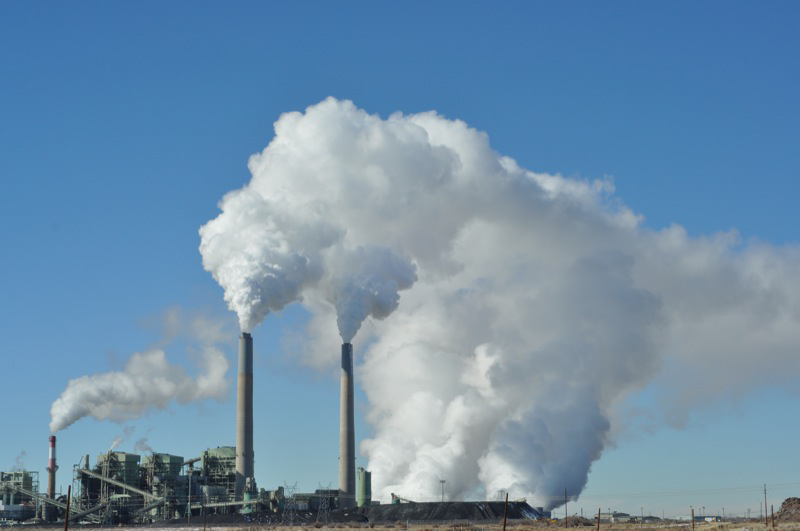
Administrator McCarthy has been in charge of the clean power plan, designed to reduce CO2 emissions from the nation’s power plants. (Photo: Glennia, Flickr CC BY-NC 2.0)
CURWOOD: It’s Living on Earth, I’m Steve Curwood. One year ago this week, President Obama gave his most expansive speech on climate change at Georgetown University. And central to his plans are regulations that would rein in CO2 emissions from power plants. Well, the person in charge of making that happen is Gina McCarthy, Administrator of the US Environmental Protection Agency. Administrator McCarthy joins us now. Gina, welcome to the program.
MCCARTHY: It's great to be here with you, Steve. Thanks.
CURWOOD: So it's been, what, a year since the president announced his full-court press to tackle climate change and gas emissions, with power plants front and center, and you were tasked with carrying out that plan. How's it going one year out?
MCCARTHY: Well, it's been very busy, Steve, as you may know. We've done a tremendous amount of outreach. We've been working with states, utilities, business groups, environmental constituencies, communities, and it's going well, and we're planning to finalize it this summer, and we're excited about it.
CURWOOD: There are a lot of deadlines in this regulatory process, different phases and all that, so how on pace are you to meet those deadlines?
MCCARTHY: Well, there's a lot of work to be done, but we've been doing a lot of work all along. It's actually a combination of rules. It's one to look at how we can build new power plants in ways that are reducing carbon pollution as much as possible, and it's also going back and looking at the existing power plants and how we can work with states to provide a flexible, but practical plan, to over time reduce carbon pollution from our existing fleet. So there's been a lot of communications, a lot of work, a lot of analysis, but we ended up with more than 4 million comments. So we have a lot to work with, we have great information, we're pretty excited that we have learned a lot and will be able to finalize this rule in a way that will keep our lights on and keep the costs affordable, but also recognize that a low carbon future is where we need to head. It is inevitable, and if the US can really move forward and modernize our energy system, as we've been slowly doing it, and make that happen over time, that investments will follow and we'll capture those economic benefits.
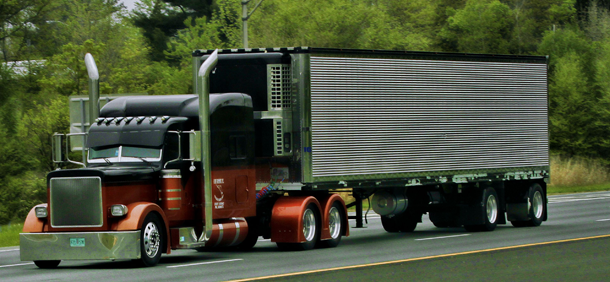
The EPA is also working on rule-making to limit pollution from big trucks. (Photo: RaymondClarkeImages, Flickr CC BY-NC 2.0)
CURWOOD: Give me a high-level look at the legal logic of these policies. There's been a lot of pushback from industry and some of the coal producing states. In particular, a number of different interests have filed appeals, of course, to try to keep this from moving forward. What's the firmest ground that you stand on in this rulemaking, and where are you most at risk, do you think?
MCCARTHY: Well, I think the good thing about this rulemaking is that we’re operating it under the Clean Air Act, and EPA's been enormously successful in utilizing the Clean Air Act to provide significant public health protections, but also do it in a way that continued to allow our economy to grow. We're going to use that same system here, so we feel that we're on solid legal ground. The President knows that we have been granted the authority to do this rule. The Supreme Court has spoken three times to us to let us know that carbon pollution is something we need to think about under the Clean Air Act and so we need to make sure to get this done in a way that's legally solid, but also a way in which we can continue to work with states to bring the kind of protections that people are looking for. Steve, I don't pretend that this is going to be easy — it's been a challenge — but it's been a challenge that we and states and utilities have been working on. And we've done it with every pollution standard we've ever done and carbon is the one that's left, and we're going to do it well. We've proposed it in a way that's flexible and we’ll get this over the finish line.
CURWOOD: So what's it like to deal with Congress? Your predecessor joked that she deserved your own parking space up on Capitol Hill since the Republican-led House is constantly calling her up for hearings. And then, of course, the Hill was slow to confirm you and they still seem reluctant to rein in climate change gases. In fact, some want to defund your agency, they want to put you out of a job. What's it like to work with those folks?
MCCARTHY: Well, I do pretty well in my work with Congress. I respect that they have jobs to do, and I think the most important thing that I've tried to do is make sure that I engage with them on the actions that were taken in a way that assures them I'm looking at a full range of considerations. The President knows that action on climate change is an imperative, it's our moral responsibility, as well as an opportunity to turn a challenge into a real economic opportunity for this country. So as long as I can continue to go up there and defend rules and decisions that I feel are solid under the law, as well as provide American families clean air to breathe, good places to live, clean water and now a safer future, I'm a happy camper, and I'll keep going up there any time they offer and the conversations will continue, I'm sure.
CURWOOD: Now, we noticed that your agency has announced a series of other initiatives aimed at curbing greenhouse gas emissions. Talk to me a bit about the rules regarding big trucks and airplanes.
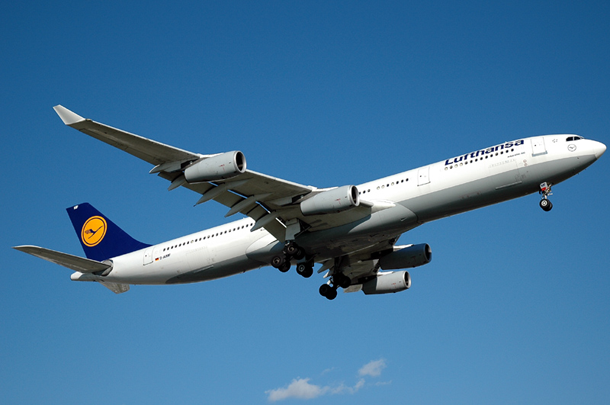
The EPA also plans to tackle emissions from airplanes. (Photo: caribb, Flickr CC BY-NC 2.0)
MCCARTHY: Yeah, the big trucks — we call them heavy-duty vehicles — that is some rulemaking that we are actually soon to be announcing as a proposal. I'm pretty excited about it, because these trucks produce a lot of emissions and a lot of carbon. And so there's real opportunities for reducing carbon pollution, but doing it in a way where we're delivering much more fuel-efficient vehicles. So if we are transporting a lot of products on the road in trucks, we can look forward to a future where our customers will pay less for those products because we'll be using less energy to deliver them and save lots of money. We're looking at methane emissions upstream in the oil and gas development sector so that we can figure out how to capture those, because it's tremendous opportunity for more cost-effective operations. Every time you leak methane, you're leaking a product. So there's great opportunities there. And I think, you know, we recently put out an advance notice of proposed making and a proposed endangerment finding on aircrafts, on large aircraft. That's an opportunity for us to work in an international context, to take a look at what the world thinks about reducing carbon pollution and what the U.S. obligation would be under those international agreements, if and when they come forward.
CURWOOD: You don't supposed there will be any flap over that, do you?
MCCARTHY: Well, you know, there's always been EPA flak over just about everything we've done, but, honestly, we've proven skeptics wrong each and every time. And we're going to keep doing that because we're going to keep our public-health and environment protection mission alive here at this agency. And I'm going to be facing up to the challenges in making decisions based on science facts and based on our ability to keep the economy moving forward, and we think will do just fine.
CURWOOD: So, come the late fall, early winter, big climate negotiation session in Paris. But first let me ask you, what's your take on what Pope Francis is saying about the necessity to address climate disruption?
MCCARTHY: Well, there's a lot of alignment between what the Pope is saying and what the President has announced when he put out his climate action plan a few years ago, and that is that we have a moral responsibility to protect our natural resources. Most of us are very excited about the Pope's encyclical. We have been hearing from and working with folks of all faiths who are concerned about climate change, concerned about what it does for God's creation, and working with us to identify opportunities to talk to people of all faiths about what they can do as individuals and what the President hopes to do in this country to drive domestic carbon pollution down. But really, equally importantly, is to use that as an opportunity to really garner support for the kind of global action that we need to take. And in the meantime the working really hard on adaptation with local communities and states, to make sure that California has all the tools that we can help it with to get over the droughts, that Texas and its flooding can help protect themselves when the next flood comes, and looking at the wildfires and all other things that we need to do, recognizing that the climate's already changing, but certainly well aware that mitigation can stop that change from becoming even more intolerable than it is today.
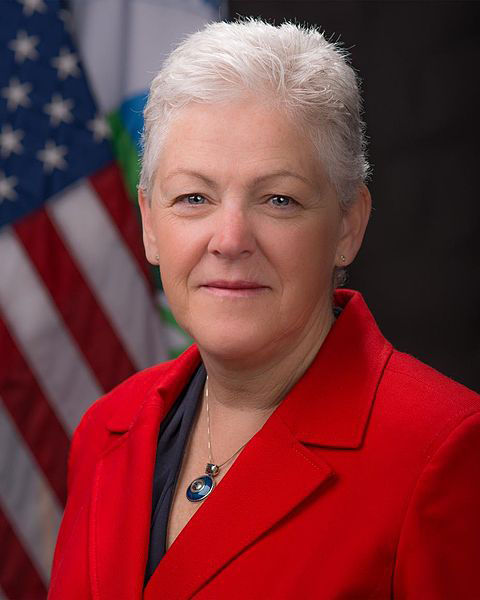
Gina McCarthy (Photo: Environmental Protection Agency)
CURWOOD: What has your role been with the inter-agency task force in advance of the Paris negotiations?
MCCARTHY: Well, we work pretty directly with the Secretary of State, Secretary Kerry, and with his climate envoy Todd Stern on their international discussions. But, frankly, a lot of the emphasis that people are coming to me to talk about has to do with the work that EPA is doing. They see it as really game changing. When EPA stepped forward and announced our clean power plan as part of the President's climate action plan, it really did change the international discussions. We have visitors from all over the world coming in and asking what we're doing, is this really happening, can you get this done. And it's wonderful to be able to meet with them and to see that they're paying attention to these issues, they're getting reengaged and the international community is really sitting up and taking notice. So what the President wanted to do is actually happening. He wanted to show that if the US takes strong domestic action, we can engage other big players like China, which we have engaged. And in Paris we can have an entirely different discussion, and one that we hope will lead to an aggressive strategy moving forward.
CURWOOD: Administrator McCarthy, there's a year and a half left for the Obama administration at this point. What do you hope to achieve in that time, and how do you want people to remember this administration when it comes to the environment?
MCCARTHY: Well, when it comes to the environment we have a lot of work to do. Climate is clearly number one, it's highest on the President’s agenda and mine as well. So we're going to deliver on all of these efforts moving forward, but we have more to do than that. We have an ozone standard that we'll be looking at, we did a new clean water rule that's attempting to provide clarity on what waters need to be protected federally and at state levels. And we're going to keep moving forward with a range of current challenges that we’re facing and try to leave this agency with the full knowledge that we've done the best we can to follow the science and the law, and to ask folks to consider and take reasonable steps, as we have always done. And I'm personally hoping that I leave this agency better positioned for the future than it was when I came in here.
CURWOOD: Gina McCarthy is the Administrator of the United States Environmental Protection Agency. Thanks so much for taking the time with us, Administrator.
MCCARTHY: Great to be here, Steve. Thanks.
Related links:
- Gina McCarthy on Twitter
- Read more about the Administrator of the EPA
- Read an article Ms. McCarthy wrote on the Economics of Fighting Climate Change
- Proposed Power Plan Rule
- “Proposed Rule for Big Trucks Aims at Cutting Fuel Emissions”
- “E.P.A. Takes Step to Cut Emissions From Planes”
- Oil and Natural Gas Air Pollution Standards
[MUSIC: Bruce Cockburn, “Last Night of the World,” Rounder/UMGD, Americana 1999]
Beyond the Headlines
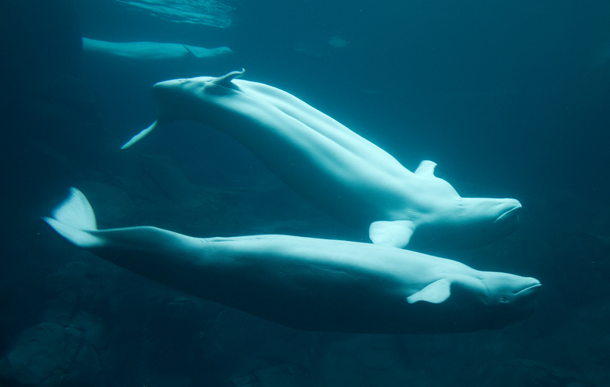
Three beluga whales were spotted in rivers along New Jersey’s shore. They were previously sighted in Rhode Island’s Narragansett Bay and along the coast of Long Island. Some scientists are concerned because belugas typically live in colder Arctic waters and whales find rivers hard to navigate. (Photo: Brian Gratwicke, Flickr CC BY 2.0)
CURWOOD: Well, let’s go beyond the headlines now. As usual, we turn to Peter Dykstra of Environmental Health News, EHN.org and the DailyClimate.org for a sidelong view on the news. He’s on the line from Conyers, Georgia. Hi, Peter.
DYKSTRA: Well, hi Steve. I have a little marine mammal mystery for you. Three young beluga whales, natives of the cold waters of the Arctic, showed up a few weeks ago at the Jersey Shore.
CURWOOD: Jersey shore — hey, how ya’ doin’?
DYKSTRA: How ya’ doin’? They were spotted in May in Narragansett Bay in Rhode Island — these are whales that are almost never spotted off the Atlantic coast of the US, and they’ve since moved farther south, swimming against the conventional wisdom that much marine life is moving north as ocean temperatures rise.
CURWOOD: Yeah, and ocean waters off New Jersey can get really warm in the summer. What kind of risk is this for belugas?
DYKSTRA: It’s quite possibly a risk. Scientists are keeping a close eye on the trio, and in those crowded waters, boat traffic and other human activity is a risk. And federal officials have a friendly warning for beachgoers at the Jersey Shore: you touch my whales, I bust you under the Marine Mammal Protection Act.
CURWOOD: So three Jersey Shore belugas. Let’s name them Springsteen, Soprano, and Snookie, huh? OK, what’s next.
DYKSTRA: Well, you know I spent 18 years as a management weasel in TV news, so I pay close attention to how little attention environmental stories get. But over at the Weather Channel, a major redemption may be underway. They’ve assembled “The Climate 25,” influential voices from unexpected places hoping to change a few reluctant minds about climate change.
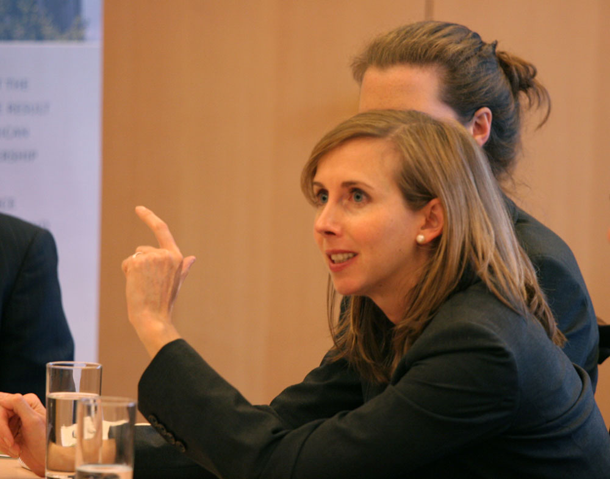
Heidi Cullen is the chief scientist for Climate Central, a nonprofit environmental organization. She is also the author of The Weather of the Future and a former on-air climate expert for The Weather Channel. (Photo: United States Mission Geneva, Flickr CC BY-ND 2.0)
CURWOOD: Interesting. So who made the list?
DYKSTRA: A remarkable number of military men, CEO’s, and Republicans. James Woolsey, the former CIA director; Hank Paulson, who was George W. Bush’s Treasury Secretary; Paul Polman, CEO of Unilever. All delivering short, sharp messages intended to sway those who aren’t yet convinced that climate change is a huge problem. But there’s one name among the 25 that represents a sweet redemption.
CURWOOD: And who would that be?
DYKSTRA: Heidi Cullen, a really smart scientist who for years was the only climatologist with a regular national TV presence — on the Weather Channel. But then in 2008, NBC Universal, the new owners of the Weather Channel, staged its annual “Green is Universal” environmental promotion across all the NBC networks. And in the middle of “Green is Universal” week, NBC gave pink slips to Heidi and her science team at the Weather Channel.
CURWOOD: I suppose they got pink slips on recycled paper, with soy ink, maybe?
DYKSTRA: Presumably, but she’s now back among the powerful voices on climate change as part of this apparently big redemption at the Weather Channel. I’m looking forward to it.
CURWOOD: That sounds worth seeing. So what do you have for us on the history calendar this week?
DYKSTRA: Well, this is the time of year when Hollywood unleashes its summer blockbuster movies, and for two straight years back in the mid seventies, these had unexpectedly strong environmental themes. In 1974, it was “Chinatown,” the film noir classic with Jack Nicholson and Faye Dunaway — a murder mystery all wrapped around the dirty business of water rights in Southern California.
CURWOOD: And that’s a theme that resonates today with the drought out west.
DYKSTRA: It does indeed. And another Hollywood classic released in 1975, forty years ago this week: “Jaws.” Bad, bad shark terrorizes a mythical New England beach resort. The movie set off such an anti-shark backlash that Peter Benchley, who wrote the book it’s based on, later said he regretted it all. Late in life, Benchley became a vocal advocate for protecting sharks. But you know who might be the most important environmental notable in “Jaws?”
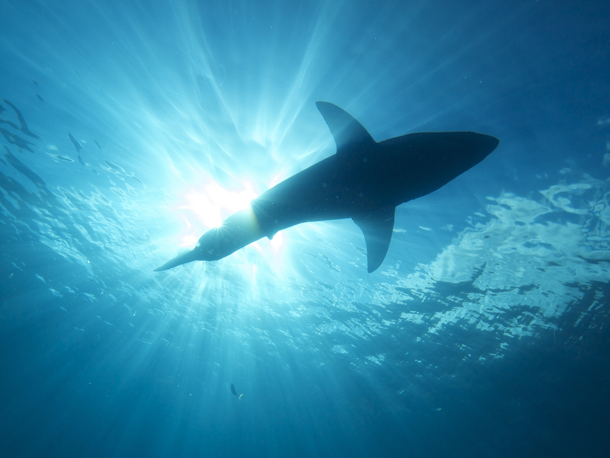
Peter Benchley’s 1974 bestseller Jaws sold 20 million copies, which led to a hit Hollywood film. He later advocated for shark conservation as a spokesman for the Environmental Defense Fund. (Photo: Elias Levy, Flickr CC BY 2.0)
CURWOOD: The marine biologist?
DYKSTRA: That’s a good guess, but I’m going with the Mayor. He’s mortified at the prospect of losing the beach season to fear, so he runs up and down the beach in his classic 1970’s polyester suit saying “There are no sharks at Amity Island.” Shark denial as a predecessor to climate denial.
CURWOOD: I’ve gotta ask, Peter, these were epic movies, but how did they do at the Oscars?
DYKSTRA: Chinatown got eleven nominations but only one Oscar. Godfather II killed that year, no pun intended. Jaws got four nominations, won two of them, including for that unforgettable shark music from John Williams.
[MUSIC – Main Theme, Jaws, John Williams, The Music of John Williams, 40 Years of Film Music Silva Screen Record, 2003]
CURWOOD: Ah, yes, who could forget! Peter Dykstra’s with Environmental Health News — that’s EHN.org — and The Daily Climate. Thanks, Peter!
DYKSTRA: All right Steve, thanks a lot. Talk soon.
CURWOOD: And there’s more at our website, LOE.org.
[MUSIC – JAWS theme continues]
Related links:
- Three beluga whales sighted off of New Jersey
- NOAA Marine Mammal Protection Act Overview
- The Climate 25
- Climate Central Heidi Cullen profile
- Heidi Cullen’s The Weather of the Future NY Times book review
- Peter Benchley became a shark advocate after writing Jaws
CURWOOD: From one scary creature to another, the vulture.
BirdNote®: A Big Black Gas Leak Detector
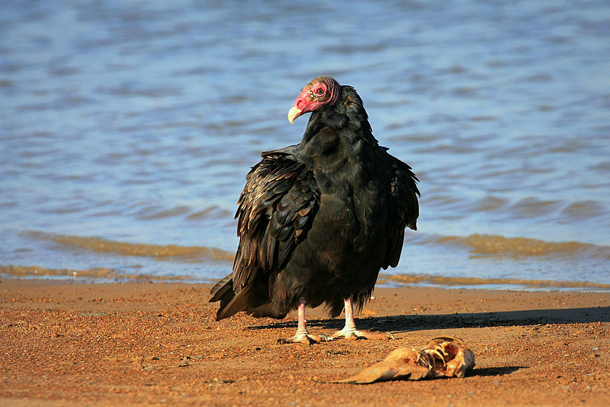
Turkey Vultures belong to the raptor family. They provide important ecosystem services: eating animal carcasses. This helps to minimize the spread of disease to other animals and regions. (Photo: Ken Slade)
[MUX - BIRDNOTE® THEME]
CURWOOD: Birds that feast on carrion send shivers down the spine for many of us, even though they perform a beneficial role in recycling organic matter. And as Mary McCann explains in today’s BirdNote®, there is another useful function that turkey vultures seem able to perform.
BirdNote® Turkey Vultures and Gas Pipelines
MCCANN: In the late 1950s, scientist and ornithologist Kenneth Stager set out to answer, once and for all, a question that has been argued over for decades. Do vultures detect carrion by sight or by smell?
The story goes that his lightbulb moment came when a Union Oil employee told him of vultures congregating at the spots along pipelines where gas leaks were occurring. Why would they do that? Well, because a key ingredient in the odor of carrion is ethyl mercaptan — the same substance companies added to odorless natural gas in their pipelines, so they could smell if there was a leak. With just about the keenest sense of smell in nature, Turkey Vultures can detect this odor in the air at even a few parts per trillion.

Turkey Vultures are foragers that eat carrion, decaying animals. Flying slowly and at low altitudes helps them locate carrion. (Photo: Jamie Chavez FCC)
So Stager rigged up a mercaptan-emitting machine, took it into the field, and recorded his results. Definitively, he proved that vultures find their prey because of its smell.
Today, there are more sophisticated ways to track pipeline leaks. But who knows? … Now and again, a watchful worker may just cast an eye upward, on the lookout for ominous silhouettes slowly circling against the blue sky.
I am Mary McCann.
###
Written by Bob Sundstrom
Bird sounds provided by The Macaulay Library of Natural Sounds at the Cornell Lab of Ornithology, Ithaca, New York. Desert ambience: “002 Wind Mod Soft” and “132 Desert Morning Bird Chorus” Nature SFX recorded by Gordon Hempton of QuietPlanet.com
BirdNote’s theme music was composed and played by Nancy Rumbel and John Kessler.
Producer: John Kessler
Executive Producer: Dominic Black
© 2015 Tune In to Nature.org June 2015 Narrator: Mary McCann
Key source: http://davidhaviland.com/?p=13]
Also: http://www.allaboutbirds.org/guide/Turkey_Vulture/lifehistory
http://www.bedfordaudubon.org/birds/vultures01.html
https://baynature.org/articles/comes-smell-turkey-vulture-stands-nearly-alone/
Related links:
- About Turkey Vultures and gas leaks on BirdNote®
- More on turkey vultures
- All about birds: turkey vulture
[MUSIC: Girl, Ilhan Ersahin, Nil Karaibrahimgill. Putamayo World Music, Putamayo Recordong Euro Lounge, 2003]
CURWOOD: Coming up: a trip to the jungles of Laos in search of one of the rarest animals living on earth. That’s just ahead. Stay tuned.
ANNOUNCER: Funding for Living on Earth comes from United Technologies, a provider to the aerospace and building systems industries worldwide. UTC Building & Industrial Systems, provides building technologies and supplies container refrigeration systems that transport and preserve food and medicine with brands such as Otis, Carrier, Chubb, Edwards and Kidde. This is PRI, Public Radio International.
[CUTAWAY MUSIC: Doc Harris Hornpipe, Danita Hartz, Doc Harris, National Old Time Fiddlers] Contest, The Grand National Championship, Makoche Recording Co, 1955]
The Quest for the ‘Asian Unicorn’

“Martha” was the first adult saola to be observed outside of its habitat. Conservationist William Robichaud gave her the name while observing her over a period of two weeks in 1996, when she was briefly held in captivity before she passed away. (Photo: William Robichaud / WCS)
CURWOOD: It's Living on Earth, I'm Steve Curwood. Deep in the forests of southeast Asia lives a creature nicknamed the Asian Unicorn, and it's nearly as rare as the mythical creature, as well. The Saola has only been known to Western science for about twenty years, and its habits and way of life are still mysteries, and it is right at the edge of extinction. Writer William deBuys accompanied conservationists on an expedition to study the saola, and his book The Last Unicorn lays out the story and the challenges of saving a species so rare. Bill, welcome to Living on Earth.
DEBUYS: Thank you. It's great to be with you.
CURWOOD: Bill, please describe the saola for us. Why is it such an enigma, and why is it nicknamed the Asian unicorn?
DEBUYS: Well, the saola was discovered to Western science only in 1992. Local villagers in the habitat of the saola, of course, have known it was there forever, but this new discovery was made when scientists saw a rack of horns on the wall of a hunter’s shack, and these horns are the most distinctive features of the saola. They're long, almost straight, and beautifully tapered to a very sharp point, so that when the saola stands profile, the two horns in perspective merge into one, and it appears to have only one horn, it appears to be a unicorn. Perhaps only dozens to a few hundred still exist, and there are none in captivity.
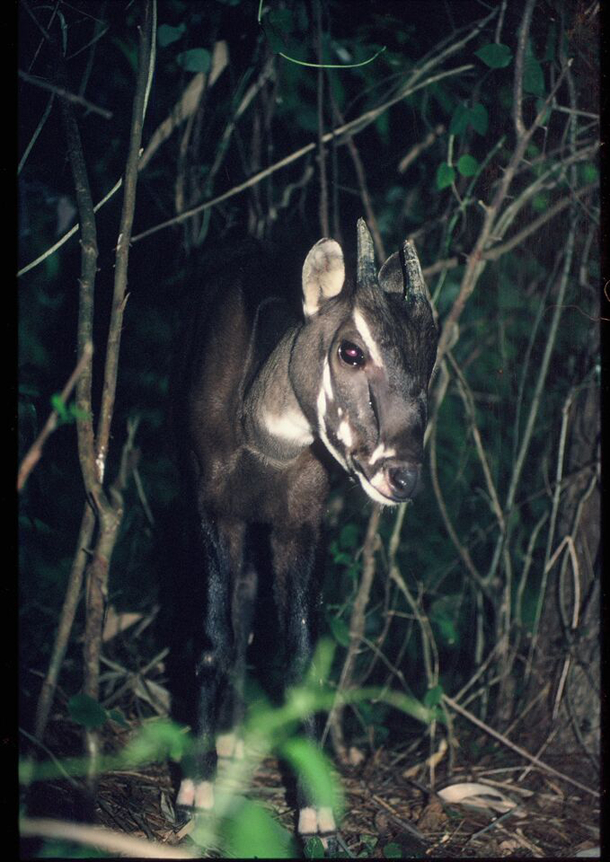
Juvenile saola held in captivity in Hanoi, 1993. (Photo: J. C. Eames)
CURWOOD: So what’s its color, how is it marked?
DEBUYS: Well, it's a beautiful animal. It has camo splashes of white on the muzzle, which may vary from individual to individual. Its body is kind of a brown almost and it has stripes of chocolate brown and white and black on its rump, which match perfectly with similar stripes on its tail. It's a somewhat stocky animal, about the size of a carousel pony. The saola is a bovid, which is to say it has cloven hooves and it chews a cud. Its nearest relatives in evolutionary terms are wild cattle, but they're really not very close relatives. The saola seems to have branched off the evolutionary tree quite on its own a very, very long time ago. One of the most striking characteristics of the animal is its seemingly serene disposition. My companion on the expedition, Bill Robichaud, was in the company of a captive saola for two weeks in 1996, and this animal was so tame in his presence that he was able to pick ticks out of its ears. He said it was tamer and more serene than any farm animal than he had ever encountered.
CURWOOD: Describe Bill Robichaud for us.
DEBUYS: Well, he's a rugged and funny fellow, and he is as passionate and energetic in the protection of wild animals — right now chiefly saola — as any person on this planet. He came to conservation through a fascination with birds, and as a teenager he climbed a tall oak tree and captured a young red tailed hawk and became a falconer. The hawk was named Genghis and led Robichaud on many a hilarious escapade. He continues to get back to Laos multiple times each year. Right now he is the coordinator of the Saola Working Group, a committee of the International Union for the Conservation of Nature, and the Saola Working Group is the chief body working to protect the saola from extinction.
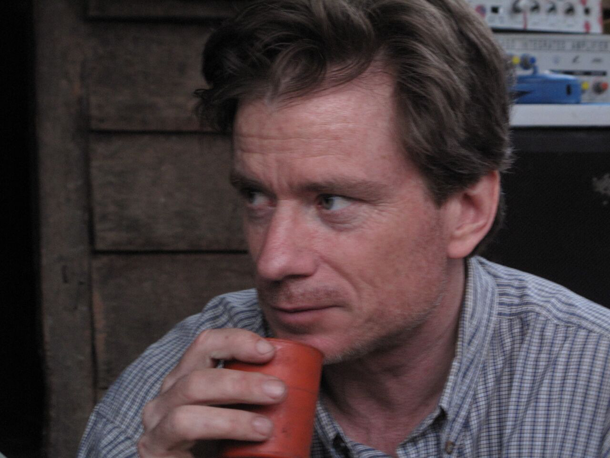
Expedition leader and conservationist William Robichaud has been working on wildlife conservation and research in Southeast Asia for nearly 25 years. (Photo: William deBuys)
CURWOOD: So this is, well, this is an amazing adventure story. What was this journey like for you?
DEBUYS: Well, it was magical in many ways. It was physically very, very demanding. The mountains were steep, the canyons were deep, the rivers were very rocky, and some days we were just climbing one waterfall after another. But we found ourselves immersed in a forest of great beauty — also great loss because of the depletion of wildlife from poaching. But the sense of beauty stayed with us all the time.
CURWOOD: Tell us what it's like there in the forest. What would you hear in the forest?
DEBUYS: Oh, the music of the forest was constantly inspiring and entertaining.
[BIRDSONG FROM LAOS]
The birdcalls never ceased. We heard laughing thrushes, and we heard drongos and Indian cuckoos and all kinds of birds with really distinctive calls. There was a kind of chorus behind us all the time.
But the most marvelous thing occurred at first light, almost every morning. We heard the calls of gibbons. Gibbons are small apes, beautiful, slender animals that swing through the trees, so gracefully, and their calls are ethereal. And they call, male to female and female to male, in mated couples, and you can think of it as almost a kind of love song that you hear echoing through the forest.
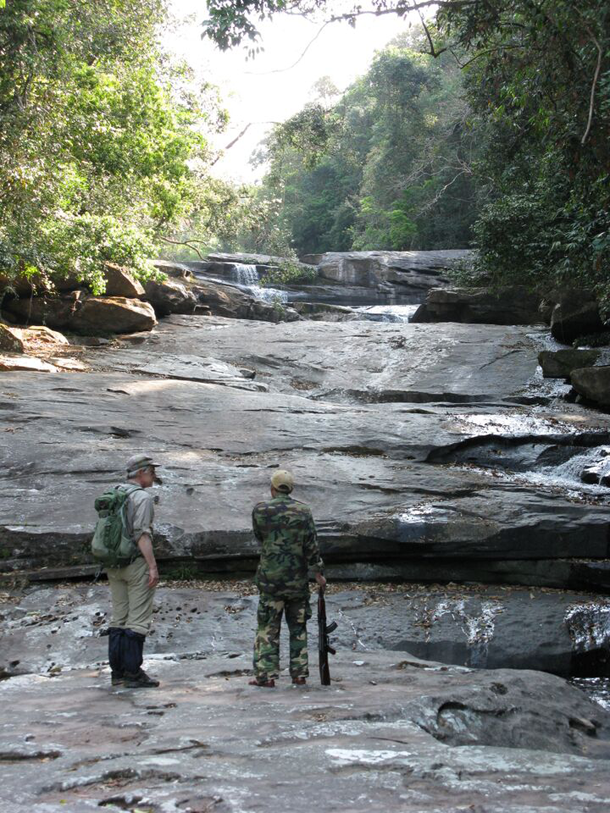
DeBuys, at left, looks upstream on a tributary of the Nam Nyang with Meet, one of the Lao guides on the expedition. (Photo: William Robichaud)
CURWOOD: Let's take a listen now.
[GIBBONS CALLING]
DEBUYS: Many a morning, I would just lie in my sleeping bag and listen and listen for as long as the gibbons were willing to call.
CURWOOD: Bill, your book isn't just a rallying cry to save a particular, a single species, it examines the broader cultural economic pressures in the forests of Southeast Asia. What are those pressures?
DEBUYS: Well, it's a land undergoing great change: manufactured goods are filtering into the remote villages deep in the forest, the pressures of poaching are rising year-by-year, as more millions of people in the expanding economies of China and Vietnam and other countries can afford to pay for expensive medicinal cures — or what they believe to be cures — that use wildlife and wildlife parts. More millions of people can also afford expensive bushmeat restaurant meals, which are a kind of source of conspicuous consumption in those societies. As economies expand, as consumer culture penetrates areas where it never had been before, the pressures on the forest are really intense.
CURWOOD: Now, why do you suppose it's people like you and William Robichaud, who come from the affluent West, where our usual and endemic species are already gone, why do you suppose you're the one writing this book rather than someone in Southeast Asia?
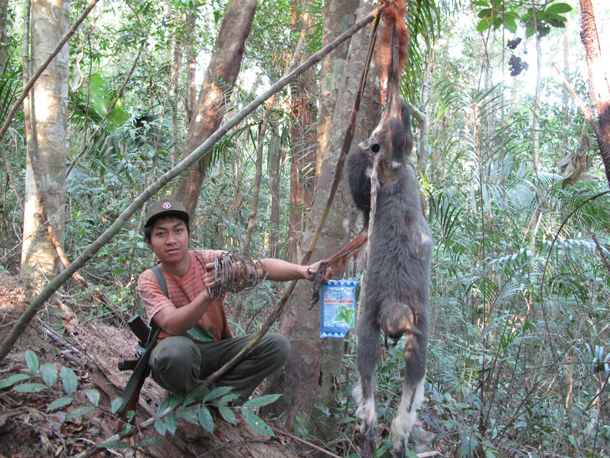
Poachers’ snare lines crisscross the remote forests in the mountains at the Laos-Vietnam border, capturing and cruelly killing countless wild animals. This douc, a type of primate, likely suffered for several hours before it finally succumbed to its injuries. (Photo: William deBuys)
DEBUYS: Well, you know there is a criticism that we need to take seriously, that Westerners are now telling people in Asia how to live. We haven't done very well by our biota, in our homes in Europe and in North America. But the fact is that the species diversity in Southeast Asia is as high or higher than any other part of the world. There are more endemic species, which is to say species that occur only there, and a higher proportion of those species are threatened with extinction than in other parts of the world. So if we globally are serious about conserving the biodiversity of this planet, then we really need to focus on Southeast Asia and hope that the countries there can preserve their natural heritage and learn from the mistakes that we have made in our own path into development.
CURWOOD: I think it's interesting you compare these pressures to those in the American West. Why did you choose to do that?
DEBUYS: Well, in an earlier life I was an American historian, and I was struck when I was in Laos with the plight of people who a generation or two ago were nomadic, and who have been settled in the same way that Native Americans in the US West were settled on reservations a century and a century and a half ago. When nomadic people are forced to settle down, they have to eat new foods, they have to change their ways, they lose contact with the spirits of their ancestors and their belief systems. They suffer heartbreak, they get sick, they're more vulnerable to disease, they have to encounter new manufactured goods, and often they have to encounter a whole lot more alcohol than they had had before. And the penetration of alcohol into the society can create all kinds of social functions, as it did on reservations in the US West. So there were big parallels that I was seeing, and one of those parallels was the sense that a war on nature was going on. In the 19th-century American West, we were losing the beaver from the streams, we were losing bison, the mountain sheep and elk were being decimated, etcetera. That same kind of loss of wildlife is going on in much of the forests of Asia right now.
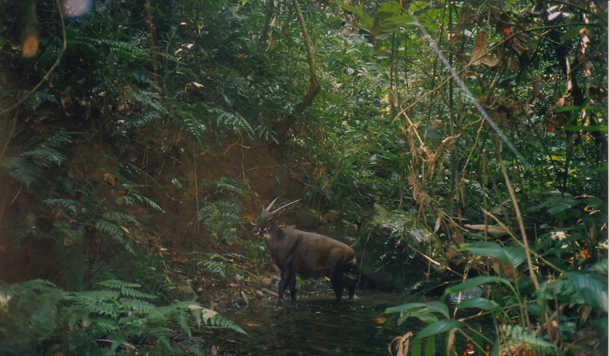
A camera trap caught this image of a saola, which may have been pregnant, in 1999. (Photo: courtesy of William Robichaud / WCS)
CURWOOD: Bill, how much wildness still can be found in the forests of Laos today?
DEBUYS: Immense amounts of the forest are still truly wild, and we even found some pockets of the wildlife community that were almost wholly intact. And so if the government of Laos and other interested parties are able to provide the protection against poachers that these forests need, their potential to repopulate themselves with wildlife, given their productivity, is very, very high. There's an enormous amount still to save there.
CURWOOD: So what are conservationists like your expedition leader William Robichaud, what are they trying to do to save the saola?
DEBUYS: Well, first of all they're trying to identify its habitat, and as I say, very little is known about some of these forests. So these forests have to be surveyed, and once habitats are prioritized, then there is an effort to see if saola are actually there. As time goes on, there may even be an effort to capture saola and put them into captive breeding programs, so that, eventually, when areas are safe from poaching, those additional animals can be put back into the wild and repopulate the natural habitat of the saola.
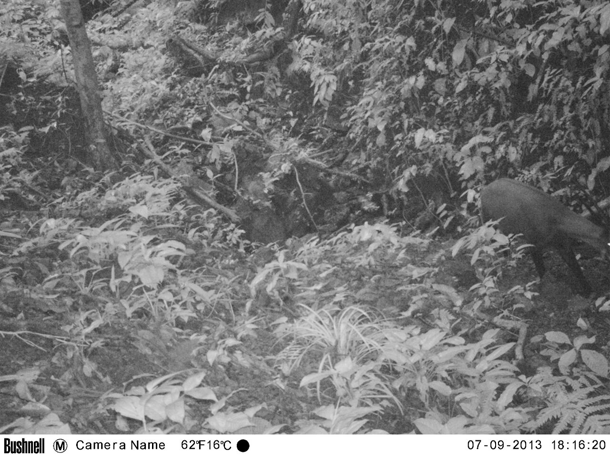
In 2013, a camera trap caught this photograph of a saola. It is the most recent photographic evidence scientists have that the saola has not yet gone extinct. (Photo: WWF Vietnam)
CURWOOD: How well do you think the attempts of Robichaud and others to engage locals in saola conservation are working?
DEBUYS: Well, the progress is there. It may be slow, but it's there. Our expedition basically had three purposes: one was to look for saola habitat and for saola in that habitat. A second was to evaluate the poaching pressure on the landscape. And a third was to conduct a kind of conservation diplomacy in the villages of the forest. We talked to headmen in the villages and to groups of elders about ways that hunting might be reformed in order to protect any saola that might be there. And one of the remarkable things that Robichaud has encountered again and again, and I on one occasion on the expedition also encountered, was a conversation that goes like this. A villager says, "Do you have a lot of saola in the United States?” and we say, “No”. “Oh, well there must be many, many saola in Africa?” We say, “No, there are no saola in Africa either, or in South America. The only saola in the world are the saola right here in these mountains.” And the villager says, "Oh my,” and makes a recognition — you can see it happening right there — that saola is something to be proud of, that his world has something the rest of the world doesn't have. And the more that pride is awakened the better the prospects for saola will be.
CURWOOD: How is the saola faring today?
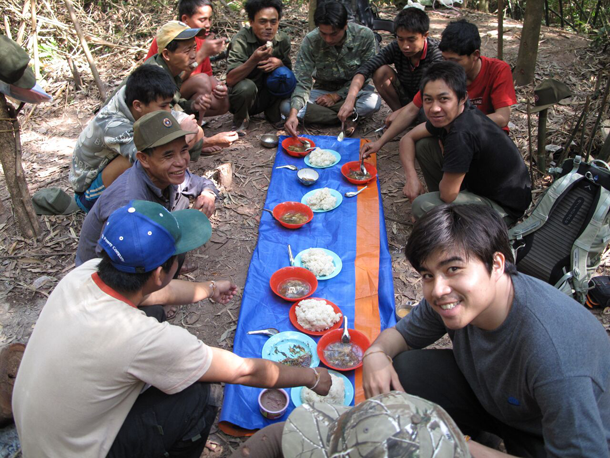
The expedition’s Lao guides and researchers enjoy a communal supper of rice and a soup made from leaves gathered in the forest, rattan, ginger, citrus, and garlic. (Photo: William deBuys)
DEBUYS: The saola . . . we don't really know because it's so hard to detect. But the advocates for saola got some very cheering news in 2013, on September 7, when a camera trap in Vietnam, very close to the Laos border, caught two pictures of a live saola. This is the first camera identification of a wild saola in more than 15 years, and so we know they're still out there. There's still something to strive for. There’s still this beautiful, beautiful creature that we hardly know, still moving around in that remote and very challenging environment.
CURWOOD: How many saola did you see?
DEBUYS: Well, we saw none. No Westerner has yet seen a saola in the wild, and the joke is that saola are so like unicorns, and everybody knows that in the Middle Ages, the only people who had an outside chance of seeing a unicorn had to be absolutely pure of heart. And Robichaud and I joke that if that applies also to saola, then we were disqualified from the get-go.
CURWOOD: [LAUGHS] This was certainly an extraordinary journey. What did it end up meaning for you?
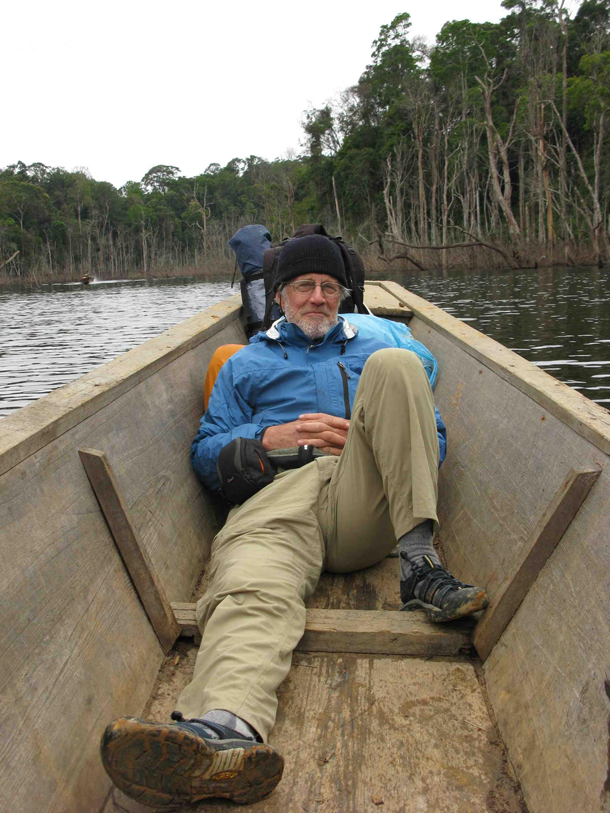
William DeBuys enjoys a moment of rest during an otherwise arduous journey. He is the author of eight books, including River of Traps, a Pulitzer Prize nonfiction finalist; Salt Dreams; A Great Aridness; and The Walk, an excerpt of which won a Pushcart Prize. (Photo: William Robichaud)
DEBUYS: Well, the book is a quest, and the quest may be the oldest form of literature in human culture — think of The Odyssey, think of Gilgamesh, of the Jews leaving Egypt and seeking the promised land — and as with a lot of quests, we didn't find what we set out to find, but we found something else. We found an encounter with deep beauty. And we also found, or I found, a sort of psychological and spiritual space in which optimism and fatalism became recognized. This is really the story of the book, and it's the story of the expedition for me. You know, if we look at the world, we see a lot of bad news, we see a lot of defeat, we see a lot of things going wrong, we see erosion of all kinds of things. But at the same time, beauty always remains. And there's a lot of beauty out there, yet to be defended, yet to be protected, and that task of protecting what remains, I think, is inherently meaningful, and that meaning is inherently optimistic. Just because you're realistic about how bad things are, it doesn't mean for an instant that you would want to give up. It only means that you want to work harder to protect what's there.
CURWOOD: William deBuys is the author of “The Last Unicorn: A Search for One of Earth's Rarest Creatures” and seven other books. He's also a Pulitzer Prize finalist and a recipient of the Pushcart Prize. Thanks for taking the time for us to talk today, Bill.
DEBUYS: Steve, it's been a great pleasure. Thank you.
[BIRDSONG FROM LAOTIAN JUNGLE]
CURWOOD: Bill deBuys recorded these sounds in the forests of Laos.
Related links:
- IUCN Red List about saola
- Saola Working Group
- About the lead conservationist on the expedition, William Robichaud
- Poaching pressures in Southeast Asia impact endangered species
- Tracking black markets in wildlife trade
- About the global wildlife trade
- Books by William deBuys
[MUSIC: Beale Street Blues, Cab Calloway and His Orchestra, Best of the Big Bands, Columbia, 2011]
CURWOOD: Next time on Living on Earth: humans are changing the world – so birds are changing their tune….
WEBSTER: What was surprising is if you go higher in elevation on the exact same mountain, the birds low down on the mountain sing different songs than birds higher up on the mountain. :09
CURWOOD: Chemicals, noise pollution and other ways we’re affecting the birds. That’s next time on Living on Earth.
[MUSIC: Beale Street Blues, Cab Calloway and His Orchestra, Best of the Big Bands, Columbia, 2011]
CURWOOD: Living on Earth is produced by the World Media Foundation. Our crew includes Naomi Arenberg, Bobby Bascomb, Jenni Doering, Emmett Fitzgerald, Lauren Hinkel, Shannon Kelleher, Helen Palmer, Adelaide Chen, John Duff, James Curwood, and Jennifer Marquis. Our show was engineered by Jake Rego, with help from Noel Flatt and John Jessoe. Alison Lirish Dean composed our themes. You can find us anytime at LOE.org - and like us, please, on our Facebook page - it’s PRI’s Living on Earth. And we tweet from @LivingOnEarth. I'm Steve Curwood. Thanks for listening.
ANNOUNCER1: Funding for Living On Earth comes from the Grantham Foundation for the protection of the environment, supporting strategic communications and collaboration in solving the world’s most pressing environmental problems. The Kendeda Fund, furthering the values that contribute to a healthy planet, and Gilman Ordway for coverage of conservation and environmental change. Living on Earth is also supported by Stonyfield Farm, makers of organic yogurt, smoothies and more. www.stonyfield.com.
ANNOUNCER2: PRI. Public Radio International.
Living on Earth wants to hear from you!
Living on Earth
62 Calef Highway, Suite 212
Lee, NH 03861
Telephone: 617-287-4121
E-mail: comments@loe.org
Newsletter [Click here]
Donate to Living on Earth!
Living on Earth is an independent media program and relies entirely on contributions from listeners and institutions supporting public service. Please donate now to preserve an independent environmental voice.
NewsletterLiving on Earth offers a weekly delivery of the show's rundown to your mailbox. Sign up for our newsletter today!
 Sailors For The Sea: Be the change you want to sea.
Sailors For The Sea: Be the change you want to sea.
 The Grantham Foundation for the Protection of the Environment: Committed to protecting and improving the health of the global environment.
The Grantham Foundation for the Protection of the Environment: Committed to protecting and improving the health of the global environment.
 Contribute to Living on Earth and receive, as our gift to you, an archival print of one of Mark Seth Lender's extraordinary wildlife photographs. Follow the link to see Mark's current collection of photographs.
Contribute to Living on Earth and receive, as our gift to you, an archival print of one of Mark Seth Lender's extraordinary wildlife photographs. Follow the link to see Mark's current collection of photographs.
 Buy a signed copy of Mark Seth Lender's book Smeagull the Seagull & support Living on Earth
Buy a signed copy of Mark Seth Lender's book Smeagull the Seagull & support Living on Earth

